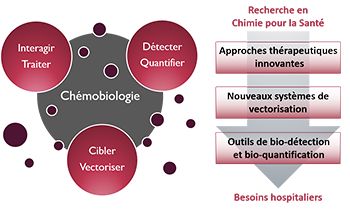- ⌂
-
Le DPM
Les Equipements
L'Environnement
Zoom sur... Le Bâtiment André Rassat
Nommé d'après une figure tutélaire de la chimie grenobloise, ce bâtiment est recouvert d’une double peau en feuille métallique qui apporte une protection thermique sur 3 côtés et crée une unité architecturale favorisant l'intégration parmi les arbres du site.
-
Thématiques
Le Thème
« Approches thérapeutiques innovantes »De nouvelles solutions thérapeutiques, de la cible biomacromolécu-laire émergente aux approches originales pour traiter les maladies
Le Thème
« Nouveaux systèmes de vectorisation »Combiner les propriétés d’inclusion de principes actifs, de franchisse-ment de barrières, d’adressage et de relar-gage en milieu vivant
Le Thème
« Outils de bio-détection et bio-quantification »Des dispositifs analytiques originaux pour la détection de cibles, de l’ion au micro-organisme en milieu complexe
Zoom sur... La Chémobiologie

-
Équipes
L'Équipe « COMET »
« COMET » développe la conception rationnelle, la synthèse et/ou l'extraction de composés à forte diversité/complexité comme nouveaux agents thérapeutiques et outils moléculaires pour la pénétration cellulaire ou la détection de biomolécules, actifs in vivo.L'Équipe « NOVA »
« NOVA » utilise des acides nucléiques fonctionnels comme éléments de reconnaissance pour des applications thérapeutiques ou diagnostiques, comme la sélection d'oligonucléotides, ou le développement de dispositifs d'analyses et de nanovecteurs.Les Services
-
Productions
Les Publications
La Vulgarisation
Les JSM
Zoom sur... La 12ème JSM (15 juin 2023)
Le DPM organise des journées scientifiques consacrées au médicament. L'objectif est de rassembler les spécialistes académiques et industriels autour d'une thématique. 2023 : Apports de la Chimie Click et de la Lumière en Chemobiologie
-
Partenariats
Les Formations
Les Consortiums
Les Financements
Zoom sur... L'environnement Grenoblois
Le DPM est un acteur central sur le bassin grenoblois en chimie, biologie et santé, lié au CHU Grenoble Alpes et à de nombreuses autres organisations : Pole de Recherche CBS, ICMG, Labex ARCANE, EUR CBH, Institut Carnot Polynat, Réseau GREEN.
Article
- Projet
- Denis WOUESSIDJEWE, Annabelle GEZE, Luc CHOISNARD,
- Titre
- New nanoparticles obtained by co-assembly of amphiphilic cyclodextrins and nonlamellar single-chain lipids: Preparation and characterization
-
[Full paper
 ]
] - Auteurs
- Nguyen, C-H ; Putaux, J-L; Santoni, G; Tfaili, S; Fourmentin, S; Coty, J-B; Choisnard, L; Geze, A; Wouessidjewe, D; Barratt, G; Lesieur, S; Legrand, F-X
- Edition
- Int. J. Pharm. 2017, 531(2), 444-456
- Année
- 2017
- Résumé
- This work aimed at prepg. new nanoscale assemblies based on an amphiphilic bio-esterified β-cyclodextrin (β-CD), substituted at the secondary face with n-decanoic fatty acid chains (β-CD-C10), and monoolein (MO) as new carriers for parenteral drug delivery. Stable binary (β-CD-C10/MO) and ternary (β-CD-C10/MO/stabilizer) nanoscale assemblies close to 100 nm in size were successfully prepd. in water by the solvent displacement method. The generated nanoparticles were fully characterized by dynamic light scattering, transmission electron microscopy, small-angle X-ray scattering, residual solvent anal., complement activation and the contribution of each formulation parameter was detd. by principal component anal. The β-CD-C10 units were shown to self-organize into nanoparticles with a hexagonal supramol. packing that was significantly modulated by the molar ratio of the constituents and the presence of a steric or electrostatic stabilizer (DOPE-PEG2000 or DOPA/POPA, resp.). Indeed, nanoparticles differing in morphol. and in hexagonal lattice parameters were obtained while the co-existence of multiple mesophases was obsd. in some formulations, in particular for the β-CD-C10/MO/DOPA and β-CD-C10/MO/POPA systems. The mixed β-CD-C10/MO/DOPE-PEG2000 nanoparticles (49:49:2 in mol%) appeared to be the most suitable for use as a drug delivery system since they contained a very low amt. of residual solvent and showed a low level of complement C3 activation




 Annuaire
Annuaire Contact
Contact Plan d'accès
Plan d'accès ENG
ENG Login
Login



